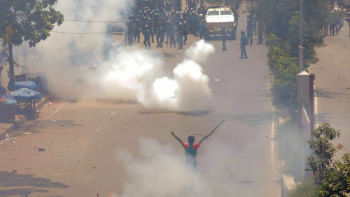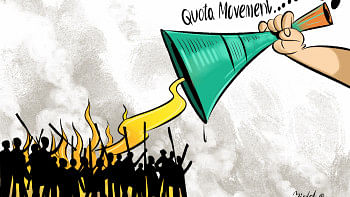How can the rulers erase so much bloodstain?

As of Thursday, at least 156 people have died in six days' of violence, per the tally recorded by this daily. The exact number of deaths is unknown; there is no certainty if it will ever come to light. One state minister said, "If law enforcement agencies come under attack, they will return fire. It is only natural that there would be some casualties."
On July 16, we saw the cold-blooded killing of Abu Sayed, student of Begum Rokeya University in Rangpur and a coordinators of the quota reform movement, at the hands of police. A viral video of his final moments showed he was quite far from law enforcement. He posed no threat, yet the police member shot him. This does not match the government's narrative.
Within such a short period of time, an unprecedented level of bloodshed took place. This exceeded even the number of deaths during the nine years' of movement against Ershad's autocratic regime, the biggest movement in independent Bangladesh. That movement was violent too; it saw arson and vandalism, too.
Now, the main question is: why did the situation escalate last week, resulting in so many deaths and injuries?
The quota system had been abolished following the quota reform movement in 2018. During a press conference on July 14 this year, Prime Minister Sheikh Hasina said she had been "utterly dismayed" and had "abolished the quotas" at that time. A circular was issued accordingly. Challenging that circular, some freedom fighters' children filed a writ, responding to which the High Court annulled it on June 5 this year, effectively reinstating the quota system. The government appealed against this decision on July 6. Not relying on the government, students of public universities began their movement again, and it was completely peaceful. On July 9, two students filed a petition, which led to the court issuing a stay order against the earlier verdict. In spite of the stay order, protests continued. The Appellate Division set the hearing date for July 21. In the meantime, several ministers made comments about the movement, such as the protesters were not following the law, they are defying the constitution, the issue must be resolved through court, the government will not bypass the court, etc. Some of those comments were condescending towards the protesters. Still, they remained peaceful.
How, then, did the protest take such a violent turn?
On July 14, the protesters submitted a memorandum to the president, saying they would launch an all-out protest if their demands were not met within the next 24 hours.
During the press conference on the same day, the PM asked, "If the freedom fighters' grandchildren won't get quotas, should the grandchildren of Razakars [Pakistani collaborators] get quotas?"
In response, DU students brought out processions that night. They chanted loudly, "Who are you, who am I? Razakar, Razakar," which naturally caused an uproar. However, the students claim that the full version of the slogan was, "Who are you, who am I? Razakar, Razakar. Says who? Says who? Shoirachar, Shoirachar (autocrat)."
On July 15, AL General Secretary and Road Transport and Bridges Minister Obaidul Quader said Bangladesh Chhatra League (BCL) would give a "fitting reply" to the student protesters who had "labelled themselves as Razakars and showed arrogance." BCL President Saddam Hussain said, "BCL is prepared to tackle this (quota reform movement) through political means."
That afternoon, BCL launched its attack on the protesters.
On July 16, the protesters and BCL both called for a rally in front of DU's Raju Memorial at 12pm and 3pm, respectively. When the unarmed general students started gathering near Raju Memorial, BCL activists attacked them with metal rods, sticks, hockey sticks and guns. Many students were injured, and eventually, the protesters were dispersed.
At night, BCL members, aided by the police, searched for and found the protesters in DU, RU and JU's residential halls and beat them up. Many were driven out of the halls.
This provoked the protesters further. On July 17, the DU coordinators of the quota reform movement asked the students to gather at Shaheed Minar with sticks. This is the first time that the protesters took up a weapon in this movement. The same situation arose in JU and RU. Police, along with armed BCL members, conducted waves of assaults against the protesters in all three campuses.
The protesters managed to put up a strong resistance as they were bigger as a group. By that night, the members and leaders—even the female ones—of BCL, a student organisation that is disconnected from the general students, were all driven out of the residential halls and the campuses of DU, JU and RU.
A major reason why a peaceful movement became violent is the attempt to quash it using BCL's muscle power and police-BGB's mindless shooting. BCL's "Helmet Bahini" indiscriminately used sticks and hockey sticks on the protesters. Who are the armed individuals, who were photographed along with the BCL men, assaulting the students? Are they BCL members? It is assumed that they may have been outsiders, whose machete attacks injured many students, which further enraged the protesters.
Police and BGB fired lethal and non-lethal bullets at the students, as evidenced by published videos and photos in newspapers. This is not the conventional way of dispersing a protest. It seems it was not the police or BGB's goal to fire shots in order to scare the protesters and disperse them; it seemed they meant to shoot at the protesters.
Throughout the protest, the government repeatedly mentioned a "third party." Some intelligence high-ups mentioned that certain elements had "infiltrated" the movement.
The quota reform movement was led by anti-discrimination students' movement. This apolitical movement gained popular support from the entire student community. Undoubtedly, certain members of Chhatra Dal, Shibir and leftists, along with BCL members also joined the cause. More than 50 BCL leaders resigned from their posts and aligned themselves with this movement. But the leadership and majority participation came from general students. Chhatra Dal and Shibir never came close to assuming the leadership.
Yet, the government tried to contain the movement with a hardline and brutal approach, which raised casualties.
Why did AL leader Obaidul Quader, who is a former journalist and veteran politician with roots in student politics, want to use BCL to deal with such a widely supported movement? Now he can never escape the blame for what happened; his part in this mayhem will be revisited time and time again.
Even Law Minister Anisul Huq, who is an experienced lawyer, failed to show prudence. By the time he asked to sit with the students and announced intent to expedite the appeal hearing date, the situation had already spiralled out of control. Had the government sat with the students for a discussion beforehand, the situation could have unfolded differently.
This reminds me of Pablo Neruda's poem "I'm explaining a few things":
Come and see the blood in the streets.
Come and see
the blood in the streets.
Come and see the blood
in the streets!
Since independence, we have not seen so much blood being spilt during a movement. On whose hands is this blood? Can the rulers answer this question?
Translated from Bangla by Mohammed Ishtiaque Khan.
Golam Mortoza is the editor of The Daily Star Bangla.
Views expressed in this article are the author's own.
Follow The Daily Star Opinion on Facebook for the latest opinions, commentaries and analyses by experts and professionals. To contribute your article or letter to The Daily Star Opinion, see our guidelines for submission.

 For all latest news, follow The Daily Star's Google News channel.
For all latest news, follow The Daily Star's Google News channel. 














Comments